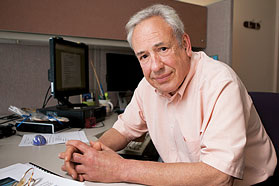Two hidden stories of cancer research

The metaphor also might apply to the impressive UC Davis Comprehensive Cancer Center research described in Synthesis. Exciting research gets reported, but it’s difficult to convey the challenges creating the framework essential for results, a process that can require dozens of people working for a decade or more.
Indeed, an important reason for the center’s earning the National Cancer Institute’s "comprehensive" designation is that cancer research leaders have promoted transformation of the technology and research environment over the past dozen years. This environment is itself a character in the cancer center’s story.
Ralph de Vere White, our center director, illustrates this in the development of cancer studies using accelerator mass spectrometer (AMS). This basketball court-sized technology can detect unimaginably small changes in a cell’s biology. By analogy, it can find a jigger of whisky in a tanker’s worth of oil, or chemically speaking, one atom among 25,000.
By next year, graduate students, post-doctoral fellows and faculty will have an amazing suite of technologies to create new ways to see cancer at the molecular level.
Twelve years ago, when the cancer center was establishing its relationship with Lawrence Livermore National Laboratory, Dr. de Vere White began discussing with Ken Turteltaub, director of the lab’s AMS facility, how it might be used to investigate cancer, and he helped the laboratory leadership petition for AMS funding from the National Institutes of Health.
Two years later, Dr. Turteltaub collaborated on an AMS project with Michael DeGregorio, a UC Davis professor in the Department of Internal Medicine, who develops new breast cancer drugs. AMS studies have since blossomed with the recruitment to UC Davis of investigators Chong-Xian Pan, in 2005, and Paul Henderson, in 2008.
AMS research has uncovered unknown processes in breast cancer, and helped in the evaluation of prostate cancer’s spread to bone long before it is clinically obvious. A new direction in personalized medicine is being tested in a study in which very small amounts of drugs are injected to determine whether a particular patient with bladder cancer will respond. The study is accruing UC Davis cancer patients.
The story of Julie Sutcliffe, a breast cancer survivor and UC Davis professor of biomedical engineering, demonstrates how devoted leadership can, over time, create whole new environments for cancer research. Dr. Sutcliffe has obtained more than $1.8 million in technology grants for position emission tomography (PET) research. For the past five years, she has energized discussions between the School of Engineering and the School of Medicine to develop a biomedical cyclotron and radiopharmaceutical facility at the medical center.
This year, UC Davis Health System and a subsidiary of Siemens Medical Solutions (PETNET Solutions) signed an agreement to build state-of-the-art research labs along with manufacturing capacity for standard PET agents for medical center imaging. By next year, graduate students, post-doctoral fellows and faculty will have an amazing suite of technologies to create new ways to see cancer at the molecular level.
And that’s just the tip of the iceberg.






